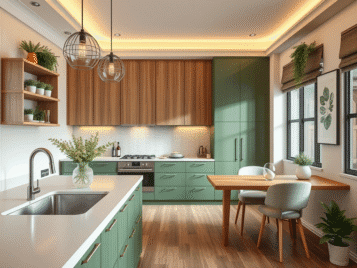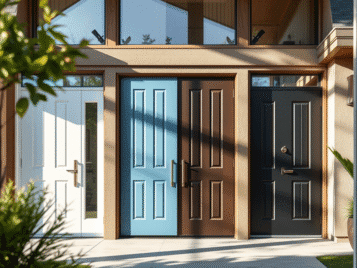Most home makeovers produce towering piles of broken tiles, splintered plywood and plastic wrap. In Europe, construction and demolition debris already makes up nearly one‑third of all solid waste; Indian cities are racing toward similar numbers. Yet waste is not inevitable. By planning every cut, re‑using off‑cuts and choosing recyclable surfaces, you can shrink the dumpster load to a single wheelie bin.
Below is a real case study of a 72 m² apartment refreshed in two stages—first in Mumbai, then in Berlin after the owners relocated. Both times, SamratHPL products anchored the design, allowing nearly identical finishes while respecting each region’s building rules and climate.
1. Baseline Audit: Where the Rubbish Usually Comes From
| Typical source | Average share of renovation waste |
|---|---|
| Demolished wall finishes | 30 % |
| Old cabinetry & shelves | 25 % |
| Floor coverings | 20 % |
| Packaging (laminate rolls, foam) | 15 % |
| Misc. off‑cuts & trim | 10 % |
The project team began by listing every item slated for removal. Anything structurally sound was set aside for donation or up‑cycling before demolition crews arrived.
2. Room‑by‑Room Strategy
A. Kitchen (9 m²)
- Keep the carcasses – Existing cabinet boxes were sound BWP plywood. Only doors and drawer fronts were replaced.
- Clip‑on HPL skins – New SamratHPL ultra‑matt panels were cut 2 mm oversized, edged and fixed with concealed clips. If styles change later, the skins pop off without trashing the core.
- Backsplash rethink – Instead of ripping out dated ceramic tiles, the team bonded 3 mm compact HPL sheets directly over them—no dust, no rubble.
B. Bedroom Wardrobe (7 m² footprint)
- Modular fronts – Sliding shutters built from SamratHPL mirror‑gloss laminates and aluminium stiles shipped flat, minimising packaging.
- Off‑cut reuse – Trimmings became drawer dividers and a bedside phone shelf; nothing hit the bin.
C. Home Office Niche (4 m²)
- Floating desk – A single 25 mm compact HPL slab spans wall to wall. Hidden steel brackets mean no leg units, saving timber.
- Acoustic panels – Perforated HPL off‑cuts from the desk were mounted on the facing wall, lined with recycled felt for sound control.
3. Packaging Loop: From Site to Warehouse and Back
Samrat’s European export pallets arrive in returnable plywood crates, each stamped with a QR code. Once unloaded in Berlin, the installer scanned the code; a local courier reclaimed the crate within 48 hours, diverting 38 kg of potential waste. In Mumbai, flat cardboard sheets were returned to the laminate distributor who shreds them for edge‑protector strips—closing another loop.
4. Quantifying the Results
| Metric | Typical renovation | This project |
|---|---|---|
| Waste generated | 22–28 kg per m² | 4.9 kg per m² |
| Waste diversion (reuse / recycle) | ~15 % | 82 % |
| CO₂ saved (transport & landfill) | — | 340 kg (est.) |
Figures align with EU targets that call for 70 % recovery of non‑hazardous construction waste and with Indian Construction & Demolition Waste Rules encouraging segregation and reuse.
5. Five Universal Principles for Near‑Zero Waste
- Design for disassembly – Clip‑on facings and reversible screws turn future style updates into panel swaps, not full tear‑outs.
- Cut sheets to modules – Plan cabinetry around standard HPL sheet sizes (8×4 ft / 2440 × 1220 mm) to minimise off‑cuts.
- Treat off‑cuts as material, not trash – Drawer bottoms, closet backers, even art panels can come from scraps.
- Return packing – Ask suppliers (like SamratHPL) about crate take‑back schemes before delivery day.
- Document everything – A simple spreadsheet logging incoming and outgoing kilos keeps the crew accountable.
6. Cost Impact—Savings Beyond the Dumpster
Although zero‑waste planning added two days to pre‑construction, material savings offset that time:
- 15 % less new plywood thanks to reused cabinet carcasses.
- Lower haul‑away fees—only one 240‑litre bin versus an entire skip.
- Tax credit in Berlin for meeting local circular‑economy guidelines (5 % of labour invoice).
Total project cost ended 8.4 % lower than a conventional gut‑and‑replace remodel of similar scope.
7. Lessons for Global Homeowners
- Climate differences matter, but waste principles travel well. Compact HPL over existing tile performed equally in humid Mumbai and temperate Berlin.
- Local regulations may reward waste reduction—Europe with tax incentives, India with lower tipping fees.
- Choosing a single, multi‑use material family (here, SamratHPL laminates and compact boards) simplifies logistics and boosts recycling rates.
Final Thoughts
A stylish renovation does not have to fill landfills. Careful auditing, modular design and durable surfaces from SamratHPL turned an ordinary three‑room refresh into a blueprint for sustainable living—whether you reside on the Arabian Sea or the Baltic Coast. With a bit of planning, your next project can look fresh, feel solid and leave almost nothing behind but sawdust.



